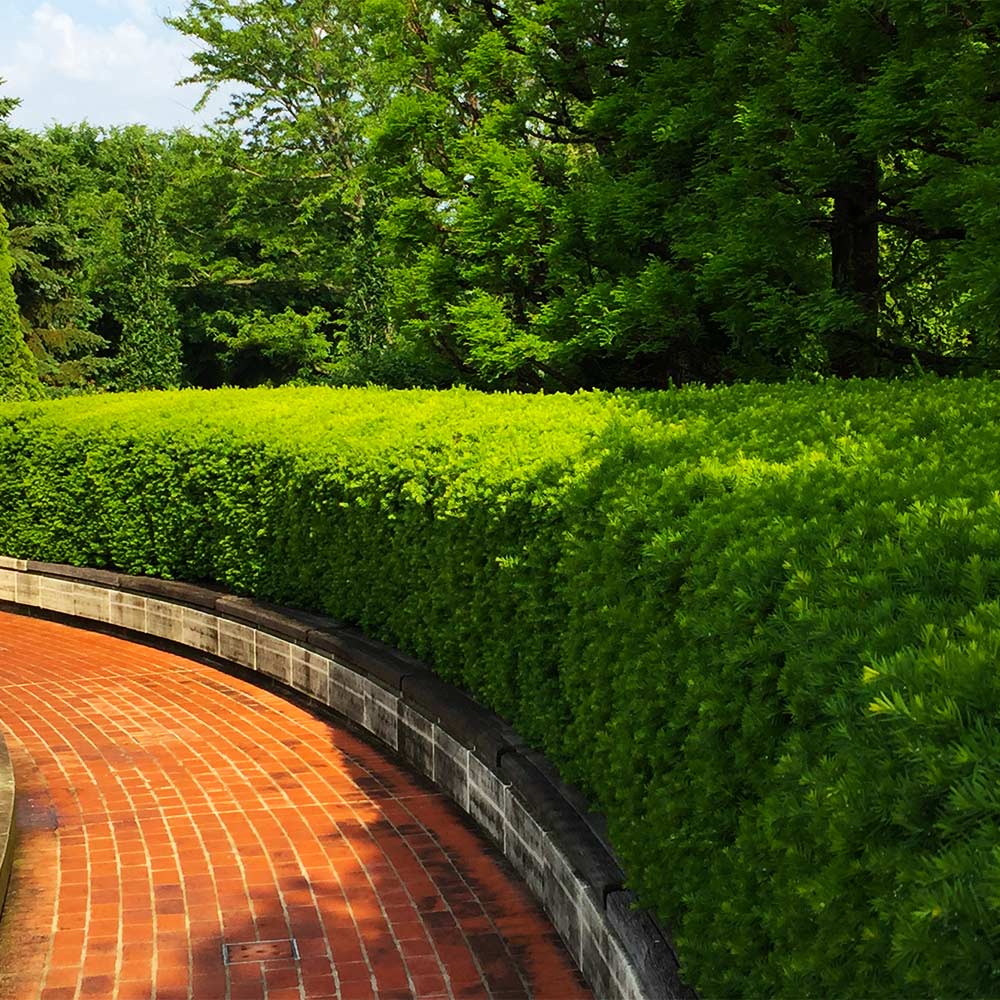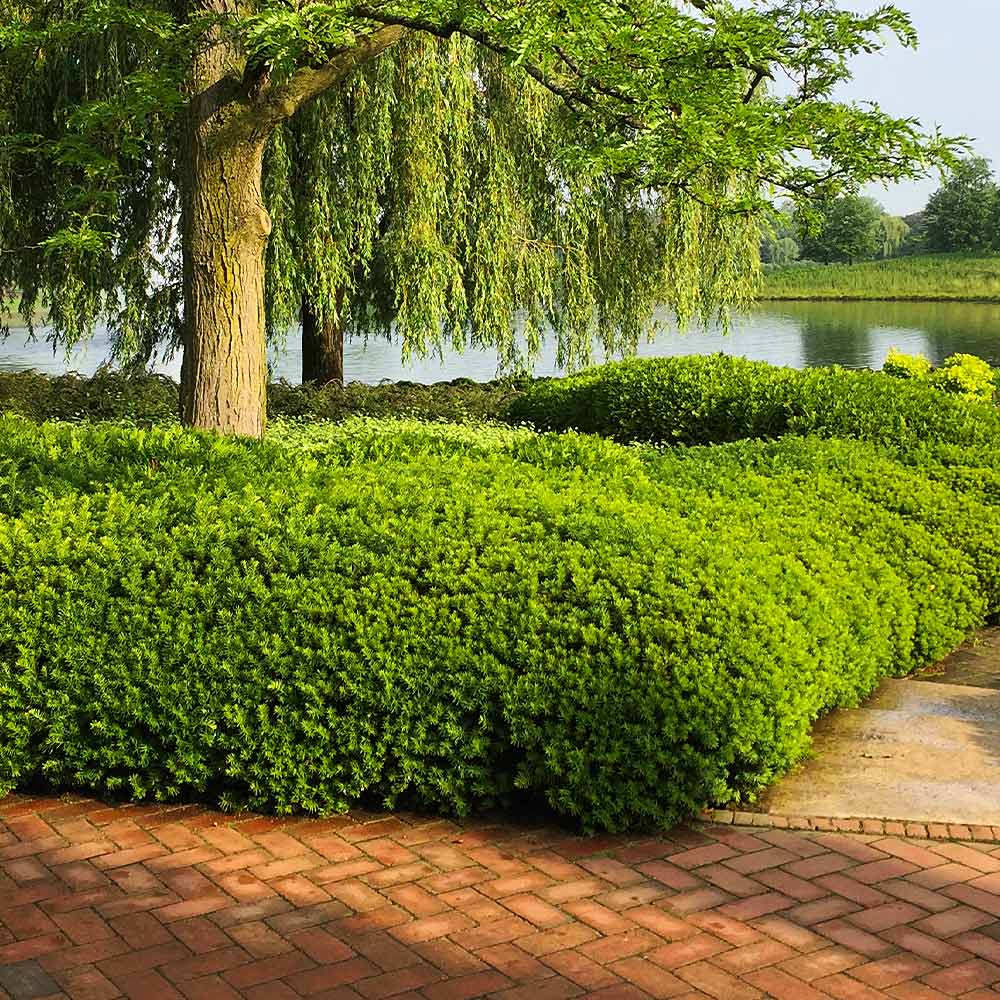Yew Trees and Shrubs
Need easy, dense growth with a pop of color that's second to none? Our Yew trees and shrubs provide ample evergreen beauty! Also known as taxus baccata, Yew tree plants are a much-loved evergreen prized for their durability, ease of care, and thick branching.
From the Hicks Yew for effortless, thick foliage to the Yew Podocarpus for curb appeal focal points, our different varieties of Yew shrubs mean getting exactly what you need for your garden. Learn more about our Yew trees for sale and their benefits below!
Types of Yew Trees and Shrubs
With over 200 cultivars of Yew, today’s most common varieties are widely used in landscaping because of their dense growth and bright green hue. Here are a few of our favorites:
Dense Spreading Yews: This dense, low-spreading shrub boasts dark green foliage and the Yew’s signature scarlet, berry-like cones for added visual interest. This lush shrub acclimates well to a variety of landscapes, tolerates shearing well, and is unlikely to be bothered by pest or disease issues, making it an ideal low-growing shrub. Achieving a mature height of 3-4 feet, this eye-catching shrub is an excellent choice for foundation planting, hedging, or bordering. It can be planted in USDA growing zones 4-7, and because of its slow growth rate, doesn’t need to constantly be attended to.
Hicks Yew Tree: Also known as the Hicksii Yew, this variety fulfills numerous uses around the garden. Growing between 8-12 feet tall, this Yew’s narrow, columnar shape makes it a great option for a taller hedge or foundation plant, but when grouped together, it’ll form a dense, evergreen barrier great for privacy or wind protection. The Hicks acts as a lively, green focal point all year long. Thriving in growing zones 4-7, this conifer shoots with vibrant new growth in the spring that darkens to a richer shade as it matures, and in the fall, female plants will dazzle with the Yew’s signature red berries.

Podocarpus: Though it’s not technically a Yew, the Podocarpus is often mistaken for the genus due to its needle-like leaves and berries. Highly adaptable and customizable, the Podocarpus can survive numerous conditions and requires little maintenance. With the ability to be trained as a shrub, tree, or even bonsai, the Podcarpus takes well to pruning and provides a beautiful backdrop with its distinctive green foliage. A great option for gardeners looking to create a privacy hedge in zones 7-11, this shrub can grow up to 20 feet!

Benefits of Yew Trees and Shrubs
With so many shrubs to choose from, it can be tough to decide what’s right for your yard. Here are some of the reasons we recommend Yews to homeowners.
Dense growth: Its thick branching and evergreen texture make the Yew a classic choice for backyard backdrops, privacy screens, and driveway dividers.
Easy care: With minimal maintenance needs, the Yew is a favorite among landscapers for its adaptability, hardiness, and slow growth that needs less trimming than other evergreen varieties.
Year-round good looks: With soft evergreen needles that won’t wither in the weather, the Yew lends a lush look to your yard, no matter the time of year.
Yew Trees and Shrubs Maintenance
Maintenance of your Yew shrubs will depend on the variety of Yew you plant, so be sure to reference your specific variety’s care instructions. However, these general directions should give you a good sense of what you’re in for should you choose to plant Yew in your yard.
Planting: Select an area for your Yew Tree that receives partial to full sun (4-8 hours) and features well-draining soil. Yews do not tend to do well with an overly wet root system, though they can handle a variety of soil types.
Watering: Water your Yew tree regularly, approximately once a week, possibly twice during in seasons of extreme heat. If you’re unsure of when to water, check the soil around your plant and if dry 2 to 3 inches down, it’s time to water.
Fertilizing: Yew trees tend to take well to fertilizer that is applied before new growth in the spring. We recommend a water-soluble 10-10-10 plant fertilizer formula for our Hicks Yew, but reference your variety’s preference.
Pruning: Light shearing supports a Yew’s dense growth and is best done when the shrub is dormant in late winter or during early spring before new growth appears.
Common Questions About Yew Trees
Where do yew trees grow?
With so many cultivars, there are varieties of Yew trees found throughout the world! Our favorite yew shrubs for sale, the Hicks Yew and Dense Spread Yew, are available for planting in USDA zones 4-7.
How do you identify yew trees?
Yew trees can be identified by their classic dense evergreen foliage, but their most notable quality are their seed cones, bright red berries that feature a small opening at the bottom.
Where are Yew trees naturally found?
Yews are found natively around the world, with the oldest cultivars located throughout Europe, Asia, and Northern Africa.
How long do Yew trees live?
Yew trees are long-lived when well cared for. Some European yew trees have even been dated back to the 10th century!
How long do Yew trees take to grow?
Most Yew tree varieties have a slow growth rate, meaning they’ll grow 12 inches or less a year.
More Evergreen Resources
Unique Evergreens to Frame Your Entryway



